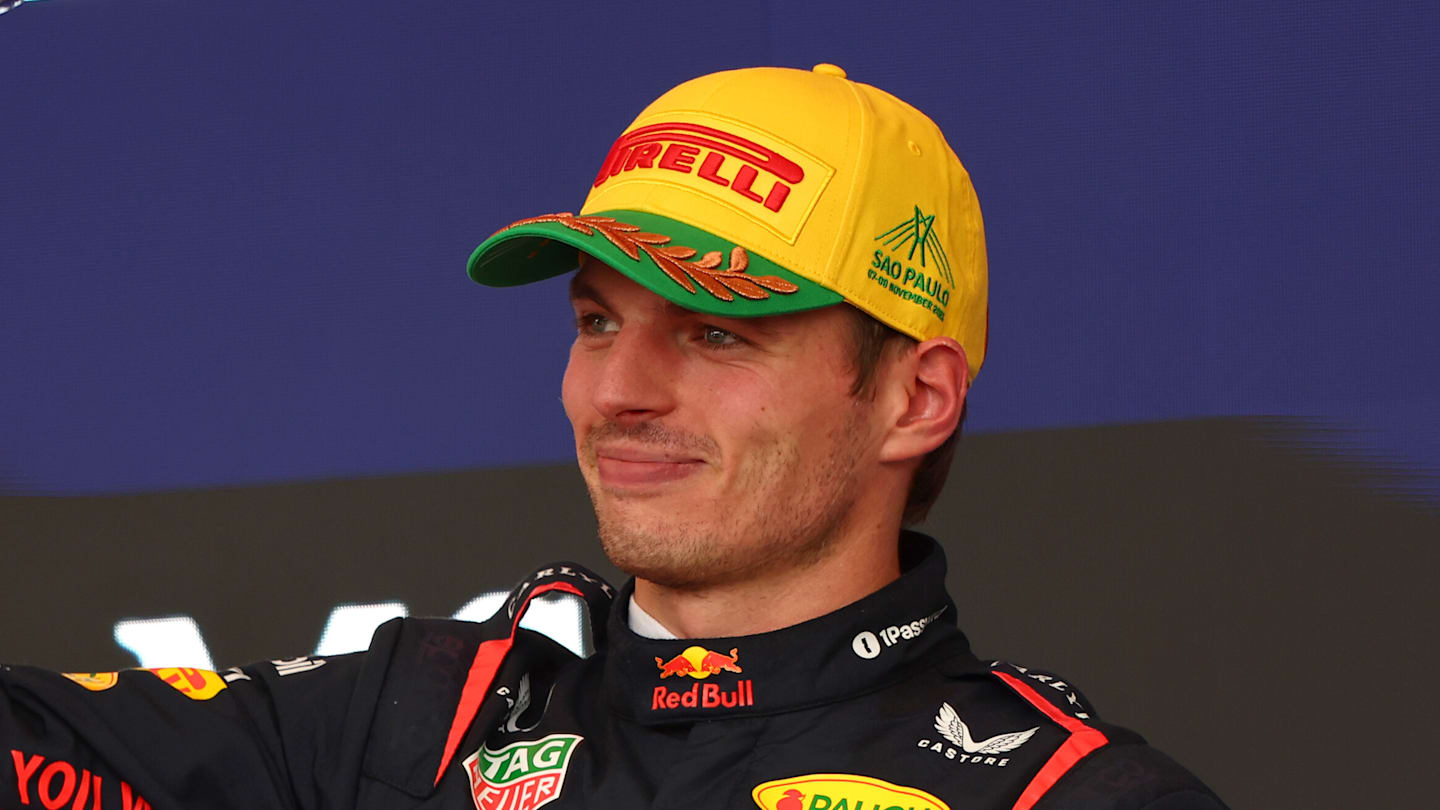In the world of Formula 1, where fortunes can turn on the thinnest margins, the Brazilian Grand Prix of 2025 will be etched into the memory as a textbook study in resilience, strategy, and pure, unadulterated speed. What began as a weekend of challenging struggles for Max Verstappen, punctuated by a disastrous mid-race puncture, transformed into one of the most compelling comeback drives of his career. The reigning champion didn’t just salvage points; he delivered a masterclass, clawing his way back from the oblivion of last place to seize a stunning P3 podium finish.
The narrative of this race, as recounted by the Dutchman himself, is not one of flawless execution, but of profound psychological strength in the face of chaos. It is a story that resonates far beyond the racetrack, speaking to the universal challenge of overcoming unexpected, crushing setbacks.

A Glimmer of Hope Before the Storm
The journey to the podium began with a significant gamble—a desperate overnight setup change. The car had been struggling throughout the practice and qualifying sessions, leaving the champion and his team searching for answers. On race day, however, a crucial shift in atmosphere and configuration seemed to have paid off.
“Well, I jumped into the car and I was only just hoping that the car would be more competitive,” Verstappen revealed, reflecting on the pre-race mood. “But the laps to the grid, it already felt better than the whole weekend, I would say.”
This initial sense of optimism was vital. It suggested that the team’s late-night adjustments—combined with a noticeable drop in temperature on Sunday—had unlocked the potential they knew the car possessed. This newfound speed offered a foundation of confidence, a belief that a strong race was not just possible, but probable. Yet, in a twist of fate only motorsport can deliver, that foundation was instantly eroded.
The Crushing Blow: Last Place, Again
The start of the race brought swift and brutal disappointment. After navigating the initial skirmishes, disaster struck—a puncture, the result of an unforeseen incident on the track. The need for an immediate pit stop sent Verstappen plummeting to the very back of the pack. The hard-won improvements, the overnight labor, and the competitive feeling were instantly negated.
“Picking up that puncture, then being last again, I was like, my God, like nothing is really going my way this weekend,” the champion admitted with a candid honesty that highlighted his frustration. It was a moment of profound psychological difficulty, where the natural instinct might be to concede defeat, to drive for minimal points, or to succumb to anger. The entire weekend had been an uphill battle, and to be knocked down again, to the very last position, felt like a cruel joke.
But this is where the champion’s true character shone through. That momentary feeling of defeat was exactly that—momentary.

The Mental Reset: Focus on the Moment
Verstappen’s response to adversity provides the core definition of the ‘Maxterclass.’ He didn’t dwell on the injustice of the situation. He performed an immediate and complete mental reset, embodying the focused determination that defines all great athletes. The goal shifted from winning to simple, relentless execution.
“You just settle in, you just try to do the best you can,” he explained. “You know, pass the cars in front of you, try to run the optimum strategy.”
The key to his success, he clarified, was the rejection of long-term thinking in favor of total immersion in the present. Even as the laps ticked down and a podium finish—P3—came into view, he refused to allow projection to cloud his judgment. “In the race, you know, you don’t really like—I’m not projecting something. I’m just focusing the moment, trying to hit every lap as consistent as I can.”
This approach is an invaluable lesson: success in high-pressure environments often comes not from dreaming of the finish line, but from perfectly executing the step right in front of you. For Verstappen, that meant treating every single lap with the same cold, calculated precision, maintaining the highest possible consistency, regardless of whether he was fighting for the lead or fighting to escape the backmarkers.
The Strategic Chess Match and the Tire Inferno
While Verstappen’s driving was masterful, it was his symbiotic relationship with the team and the strategic calls that made the comeback possible. The team executed “the right thing,” maximizing the car’s potential on different tire compounds and utilizing the track position when it mattered most.
However, the puncture’s ripple effect created a massive technical challenge that could have easily derailed the entire race. The unscheduled pit stop forced him into a deep stint on the medium tires where he had to constantly fight through traffic. This battle of overtaking was thrilling for the fans, but brutally taxing on the equipment.
“I had to pass quite a few cars,” he noted. “You’re overheating tires constantly.”
This is one of the most nuanced insights from his post-race analysis. Driving in the turbulent “dirty air” behind other cars forces the tires to work harder, generating excessive heat and leading to rapid degradation and poor grip. This compromised the medium tire’s first stint significantly, making the final ten laps of that compound a true struggle. For the average driver, this overheating would lead to major pace drop-off and potential mistakes. For Verstappen, it was a constraint to be managed and minimized, demonstrating his exceptional feel for tire management even while driving at the absolute limit.

The Technical Triumph: Setup and Temperature
Beyond the heroism of the drive, the true foundation of the comeback lay in the technical breakthrough achieved overnight. The improved feel of the car, which had been noted on the laps to the grid, was the result of profound changes.
“The message is that we found a much better feeling in the car again by changing a few bits,” he confirmed.
Crucially, he also credited an outside factor: the temperature. “At the same time, it was also quite a bit colder today, and that might also have an effect.” In Formula 1, tire performance is exquisitely sensitive to track and air temperature. It is highly plausible that the combination of the setup adjustments and the cooler conditions brought the car into a much narrower operating window where its performance potential was maximized.
This synergy—part human engineering, part environmental luck—was the engine of the comeback. The improved chassis balance allowed him to attack the corners and manage the dirty air better, while the cooler track provided the tire grip necessary to make the passes stick.
Confidence Forged in the Fire
In the end, the Brazilian Grand Prix was far more than a P3 finish. It was a statement. It proved that even when the chips are down, when fate has seemingly conspired against him, Verstappen and his team possess the ability to recalibrate, execute, and deliver results that transcend expectation.
When asked if this performance instilled confidence moving forward, particularly with a nod to the aerodynamic changes made overnight, his answer was measured but definitive. “I think everything together—setup as well. Yeah, I just felt a bit happier, and then I think also the temperatures today being a bit cooler, it just felt like everything was a bit more, yeah, boy.”
The simplicity of that final expression—”yeah, boy”—underscored the profound satisfaction of a weekend that had been rescued from the brink. The race was a “very strong race for us,” not because they won, but because they overcame seemingly insurmountable odds.
Max Verstappen’s drive in Brazil 2025 will be remembered not as a perfect victory, but as a perfect demonstration of the racing spirit: the ability to find a path to the podium when all logical avenues are closed. It was a masterclass in driving, strategy, and, above all, the relentless psychological focus required to be a champion. The P3 trophy he took home was not just a symbol of the points earned; it was a testament to the grit that turned a devastating setback into one of the season’s most impressive feats of determination.





